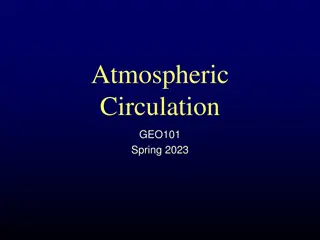Marchantia sp. Life Cycle and Anatomy Overview
Marchantia sp. is classified under Bryophyta, with a detailed lifecycle including gametophytic phases and external features like dark green dorsal surfaces with midribs and ventral surfaces bearing scales and rhizoids. The anatomy involves a photosynthetic zone and lower storage zone. Explore the fascinating biology of Marchantia sp. as outlined by Dr. Sahabuddin Ahmed, Associate Professor at Mangaldai College.
Download Presentation
Please find below an Image/Link to download the presentation.
The content on the website is provided AS IS for your information and personal use only. It may not be sold, licensed, or shared on other websites without obtaining consent from the author. Download presentation by click this link. If you encounter any issues during the download, it is possible that the publisher has removed the file from their server.
Presentation Transcript
LIFE CYCLE OF Marchantia sp. Dr Sahabuddin Ahmed Associate Professor , Dept. of Botanty Mangaldai College
Classification of Marchantia Div Bryophyta Class- Hepaticopsida Order Marchantiales Family Marchantiaceae Genus--Marchantia
Gametophytic Phase of Marchantia: External Features of Gametophyte: Dorsal surface: Dorsal surface is dark green, conspicuous midrib. The midrib is marked on the dorsal surface by a shallow groove and on the ventral surface by a low ridge. Each polygonal area re- presents the underlying air chamber. The midrib ends in a depression at the apical region forming an apical notch in which growing point is situated
Dorsal surface also bears the vegetative and sexual reproductive structures. The vegetative reproductive structures are gemma cup and develop along the midrib.
Ventral surface: The ventral surface of the thallus bears scales and rhizoids along the midrib. Scales are violet coloured, multicellular, one cell thick and arranged in 2-4 rows (Fig. 1 C). Scales are of two types: (i) Simple or ligulate (ii) Appendiculate. Appendiculate (Fig- 1 C, D) scales form the inner row of the scales close with midrib. Ligulate scales form the outer or marginal row and are smaller than the appendiculate scales
Ventral surface: The ventral surface of the thallus bears scales and rhizoids along the midrib. Scales are violet coloured, multicellular, one cell thick and arranged in 2-4 rows Scales are of two types: (i) Simple or ligulate (ii) Appendiculate. Appendiculate scales form the inner row of the scales close with midrib. Ligulate scales form the outer or marginal row and are smaller than the appendiculate scales
Anatomy of the Gametophyte: A VSof the thallus can be differentiated -- photosynthetic zone and lower storage zone
Upper Photosynthetic zone: The outermost layer is upper epidermis. Its cells are thin walled square, compactly arranged and contain few chloroplasts. Each air pore is surrounded by four to eight superimposed tiers of concentric rings. with 3-4 cells in each tier. Just below the upper epidermis photosynthetic chambers are present in a horizontal layer .Each air pore opens inside the air chamber and helps in exchange of gases during photosynthesis.
These chambers develop schizogenously (Vocalized separation of cells to form a cavity) and are separated from each other by single layered partition walls. The partition walls are 2 to 4 cells in height. Cells contain chloroplast. Many simple or branched photosynthetic filaments arise from the base of the air chambers .
Storage zone: It lies below the air chambers. It is more thickened in the centre and gradually tapers towards the margins. It consists of several lasers of compactly arranged, thin walled parenchymatous isodiametric cells. Intercellular spaces are absent. The cells contain starch. Some cells contain a single large oil body or filled with mucilage. The lower most cell layer of the zone forms the lower epidermis. Some cells of lower epidermis extend to form both types of scales and rhizoids.
Reproduction in Marchantia: Marchantia reproduces by vegetative and sexual methods. (i) Vegetative Reproduction: 1. By Gemmae: Gemmae are produced in the gemma cups ,on the dorsal surface of the thallus . Gemma cups are crescent shaped, 3 m.m. in diameter with smooth, spiny or fimbriate margins . V. S. of the gemma cup shows that it is well differentiated into two regions: Upper photosynthetic region and inner storage region .The structure of both the zones is similar to that of the thallus. Mature gemmae are found to be attached at the base of the gemma cup by a single celled stalk. Intermingled with gemmae are many mucilage hairs. Each gemma is autotrophic, multicellular, bilaterally symmetrical, thick in the centre and thin at the apex. It consists parenchymatous cells, oil cells and rhizoidal cells. It is notched on two sides in which lies the growing point .
Dissemination of Gemmae: They may also be detached from the stalk due to the pressure exerted by the growth of the young gemmae. The gemmae are dispersed over long distances by water currents. Germination of Gemmae: After falling on a suitable substratum gemmae germinate.
Development of Gemma: The gemma develops from a single superficial cell. It develops on the floor of a gemma cup. It is pap 2. Death and decay of the older portion of the thallus or fragmentation: The thallus is dichotomously branched. The basal part of the thallus rots and disintegrates due to ageing. illate and called gemma initial.
3. By adventitious branches: The adventitious branches develop from any part of the thallus or the ventral surface of the thallus or rarely from the stalk and disc of the archegoniophore in species like M. palmata (Kashyap, 1919). On being detached, these branches develop into new thalli.
(ii) Sexual Reproduction: Sexual reproduction in Marchantia is oogamous. All species are dioecious. Male reproductive bodies are known as antheridia and female as archegonia. Antheridia and archegonia are produced an special, erect modified lateral branches of thallus called antheridiophore and archegoniophore arpocephalum) respectively
Internal structure of Antheridiophore or Archcgoniophore: Its transverse section shows that can be differentiated into two sides: ventral side and dorsal side. Ventral side has two longitudinal tows with scales and rhizoids. These grooves, run longitudinally through the entire length of the stalk. Dorsal side shows an internal differentiation of air chambers
Antheridiophore: It consists of 1-3 centimetre long stalk and a lobed disc at the apex. The disc is usually eight lobed but in M. geminata it is four lobed. The lobed disc is a result of created dichotomies. L.S. through disc of Antheridiophore: Air chambers are more or less triangular and open on upper surface by n pore Called ostiole. Antheridia arise in acropetal succession i.e., the older near the center and youngest at the margins.
Mature Antheridium:A matureantheridium is globular in shape and can be differentiated into two parts stalk and body Development of Antheridium: The development of the antheridium starts by a single superficial cell which is situated on the dorsal surface of the disc, 2-3 cells behind the growing point. This cell is called antheridial initial . The antheridial initial increases in size and divides by a transverse division to form an outer upper cell and a lower basal cell .
A periclinal division is laid down in both the tiers of four cells and there is formation of eight outer sterile jacket initials and eight inner primary androgonial cells . Jacket initials divide by several anticlinal divisions to form a single layer of sterile antheridial jacket. Primary androgonial cells divide by several repeated transverse and vertical divisions resulting in the formation of large number of small androgonial cells . The last generation of the androgonial cells is known as androcyte mother cells . Each androcyte mother cells divides by a diagonal mitotic division to form two triangular cells called androcytes. Each androcyte cell metamorphosis into an antheozoid.
Spermatogenesis: The process of metamorphosis of androcyte mother cells into antherozoids is called spermatogenesis. It is completed in two phases: (1) Development of blepharoplast. (2) Elongation of androcyte nucleus. 1. Development of Blepharoplasty: In the young triangular androcyte blepharoplast appears as a dense granule in one of the acute angles. It elongates to some extent and puts its whole body in close contact with the inner contour of androcyte. From the elongated blepharoplast emerge the flagella.
Archegoniophore or Carpocephalum: It arises at the apical notch and consists of a stalk and terminal disc. It is slightly longer than the antheridiophore. It may be five to seven cm. long. The young apex of the archegoniophore divides by three successive dichotomies to form eight lobed rosette like disc.
Each lobe of the disc contains a growing point. The archegonia begin to develop in each lobe in acropetal succession, i.e., the oldest archegonium near the centre and the young archegonium near the apex of the disc. Thus, eight groups of archegonia develop on the upper surface of the disc. There are twelve to fourteen archegonia in a single row in each lobe of the disc.
Development: The development of the archegonium starts on the dorsal surface of the young receptacle in acropetal succession. A single superficial cell which acts as archegonial initial enlarges and divides by transverse division to form a basal cell or primary stalk cell and an outer cell or primary archegonial cell.
Mature Archegonium: A mature archegonium is a flask shaped structure. It remains attached to the archegonial disc by a short stalk. It consists upper elongated slender neck and basal globular portion called venter. The neck consists of six vertical rows enclosing eight neck canal cells and large egg. Four cover cells are present at the top of the neck.
Fertilization in Marchantia: Marchantia is dioecious. Fertilization takes place when male and female thalli grow near each other. Water is essential for fertilization. The neck of the archegonium is directed upwards on the dorsal surface of the disc of the archegoniophore. The antherozoids are splashed by rain drops. They may fall on the nearby female receptacle or swim the whole way by female receptacle. It is only possible if both the male and female receptacles are surrounded by water. One of the antherozoids penetrates the egg and fertilization is effected.
Sporophytic Phase: Post Fertilization Changes: After Fertilization the following changes occur simultaneously: 1. Stalk of the archegoniophore elongates. 2. Remarkable over-growth takes place in the central part of the disc. As a result of this growth the marginal region of the disc bearing archegonia is pushed downward and inward. The archegonia are now hanging towards the lower side with their neck pointing downwards
3. Wall of the venter divides to form two to three layered calyptra. 4. A ring of cells at the base of venter divides and re-divides to form a one cell thick collar around archegonium called perigynium (Pseudoperianth). 5. A one celled thick, fringed sheath develops on both sides of the archegonial row. It is called perichaetium or involucre. Thus, the developing sporophyte is surrounded by three protective layers of gametophytic origin i.e., calyptra, perigynium and perichaetium .The main function of these layers is to provide protection, against drought, to young sporophyte.
6. Between the groups of archegonia, long, cylindrical processes develop from the periphery of disc. These are called rays. They radiate outward, curve downwards and give the disc a stellate form. In M. polymorpha these are nine in number. 7. Zygote develops into sporogonium. Development of Sporogonium: After fertilization the diploid zygote or oospore enlarges and it completely fills the cavity of the archegonium. It first divides by transverse division (at right angle to the archegonium axis) to form an outer epibasal cell and inner hypo basal cell .
Mature Sporogonium: A mature sporogonium can be differentiated into three parts, viz., the foot, seta and capsule (Fig. 13 H). Foot. It is bulbous and multicellular. It is composed of parenchymatous cells. It acts as anchoring and absorbing organ. It absorbs the food from the adjoining gametophytic cells for the developing sporophyte. Seta: It connects the foot and the capsule. At maturity, due to many transverse divisions it elongates and pushes the capsule through three protective layers viz., calyptra, perigynium and perichaetium.
Capsule: It is oval in shape and has a single layered wall which encloses spores and elaters. It has been estimated that as many as 3, 00,000 spores may be produced in single sporogonium and there are 128 spores in relation to one elater. Dispersal of Spores: As the sporogonium matures, seta elongates rapidly and pushes the capsule in the air through the protective layers. The ripe capsule wall dehisces from apex to middle by four to six irregular teeth or valves. The annular thickening in the cells of the capsule wall causes the valves to roll backward exposing the spores and elaters.
Germination of Spores and Development of Gametophyte:

















































